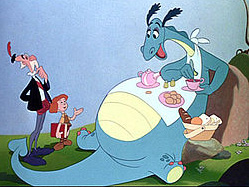Classic Movie Review: The Reluctant Dragon
By Josh Spiegel
February 21, 2011
The life and times of Walt Disney are truly fascinating, even if most of us have already concocted the man’s life in our heads thanks to plenty of help from the media. In this case, the media equals the Walt Disney Company, but the effect is the same. If we have a vision in our head of the late Walt Disney, it’s likely either extremely positive or extremely negative. He was either just like our favorite uncle, wearing worn jackets and always wanting to act like a kid again, or he was a rabid racist. There are few grey areas in the image we create of the man, but there’s more to the story. Disney was a perfectionist, and was single-mindedly obsessed with making his early movies and then his theme parks as great as they could be, no matter what the cost.
When I read the Neal Gabler biography of Walt Disney recently (a great book that I highly recommend), I was taken aback at how, after a certain point in his life, Disney didn’t really take the time or put in the effort into his films as he used to do. Disney often thought of Snow White and the Seven Dwarfs as the best movie he’d ever make, and that every film coming after was just a pale imitation in some way of what he and his animators had done in 1937. Of course, many people today would disagree, but if you want to read about the behind the scenes work on such classics as Peter Pan, Cinderella, or even Dumbo, you might be disappointed at how little work he put into the films, compared with what he did in the past.
Part of this is due to the fact that he became obsessed with creating Disneyland. For the work he did in the 1940s, which was almost expressly not feature-length stories, Disney worked heavily with the United States government to create wartime propaganda, whether it was a friendly look at Latin America (there are two such films, Saludos Amigos and The Three Caballeros), or various short films describing how air raids were how America could win World War II. One interesting piece of propaganda, though, wasn’t about the war at all, but about the still-somewhat-fledgling animation company itself. Coming out at a very bad personal time for Walt Disney, in 1941, the film is called The Reluctant Dragon. The title of the film comes from a children’s story by Kenneth Grahame, the man who wrote The Wind in the Willows, which would one day become a Disney film.
The Reluctant Dragon is a story about a child who coaxes a friendly dragon into putting on something of a show for the townspeople, who assume that a dragon would be a fire-breathing beast. The film that uses the title is both an excursion into how animated films were made and an adaptation of the story. The former is far more compelling than the latter, and part of the reason is simple: for all of the work that goes into the shoddiest of animation, if it doesn’t look great — and even back then, Disney knew how to make animation look as evocative and beautiful as any piece of art in the Louvre — it doesn’t work as a story. More than most of the animated shorts that would be combined into package films in the 1940s for Disney (Saludos Amigos and The Three Caballeros are two such films), The Reluctant Dragon just looks too cheap to be loved.
Continued:
1
2




